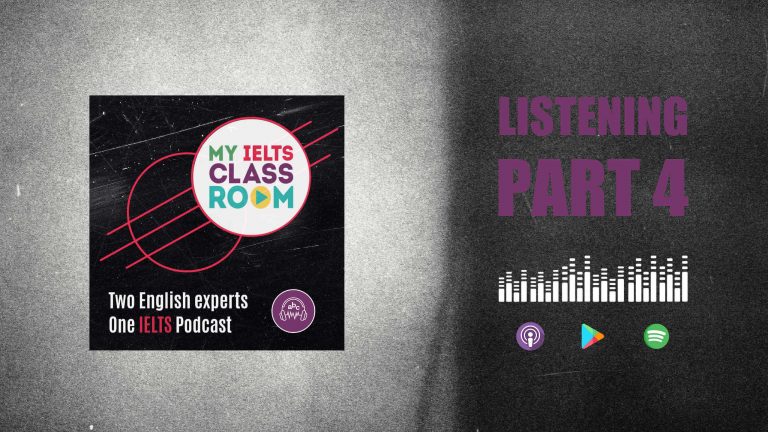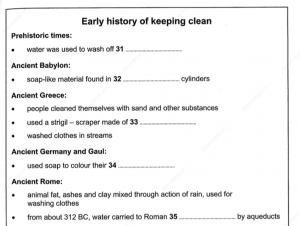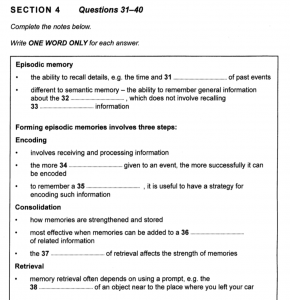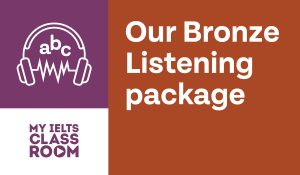
IELTS Listening Part 4
IELTS Listening Part 4
When I was a young teacher (sadly a long time ago), I used to think that IELTS Listening Part 4 was the most difficult part of the test. I mean, it seemed obvious – this was the only part of the test that asked the students to listen to a lecture and we all know that those are “difficult”. However, with time, I have realised that this actually Listening Part 3 that causes the most trouble as this requires the test-takers to listen for agreement and emotion as well as information.
Plus, lectures are designed to be understood. By this I mean that lecturers use signposting language and organise the information they are giving so that it is easy to digest – that is not the same as the conversation in Part 3 were the speakers can change their mind or suddenly change direction! Finally, the questions that are asked in IELTS Listening Part 4 today are almost always note completion.
This is fantastic as all of those notes can be used as scaffolding to help you follow the lecture. If you add to this the fact that the speaker usually stresses key words, well, you can see why the lecture is not as difficult as I once thought! Let’s listen to find out more!
This is an interactive episode so please have a pen and piece of paper ready so that you can join in the activities.
Below, you can find a summary of the episode, which includes all of the links to useful materials and the times of each part of the discussion (so you can go directly to the part you want to listen to). You can also find every episode of the podcast here 🚀
Subscribe to My IELTS Classroom podcast on Apple podcasts here
Subscribe to My IELTS Classroom on Google podcasts here
We now also have a video lesson for Listening Part 4 if you would prefer to watch instead of listen!
My IELTS Classroom Podcast Episode 58 Summary: IELTS Listening Part 4
00:00 – 04:20 Introduction (a listener is sitting the exam on Thursday – Good luck Ayomide!!)
04:21 – 09:03 Listening Part 4 – The basics
- IELTS Listening Part 4 is the the final section of the listening test and is the only one where you do NOT have a 30- second break in the middle. The speaking may pause for 2 or 3 seconds, but there is no time to read ahead.
- IELTS Listening Part 4 is always a lecture delivered by one speaker. The topic of the lecture varies but common topics are animal behaviour and the natural world, psychology, history, geology, the business world – in other words, although it’s an an academic lecture, the topic will not be very specialised (i.e. there will be not maths or legal lectures with complex terms!)
- In 2021, 99% of the time the questions in IELTS Listening Part 4 are note completion. This is a change from the past when there tended to be a wider variety of question types (i.e. multiple choice, sentence completion, matching, etc). However, this is good news as note completion is perhaps the easiest type of question for the lecture (as we will see in the episode)
09:03 – 23:55 Listening Part 4 – Before you listen
Although there is no break in the middle of the lecture, you do still have roughly 45 second to analyse the questions before the recording begins. This is actually quite a lot of time, so with a bit of practice you should be able to effectively analyse all ten questions. The first thing you should do is check how many words you can use in each space. 90% of the time it will be only one, but on occasion it can be two, so be sure to check.
If the instructions say ‘write two words and/or a number in each space”, you DO NOT need to use two words for EVERY answer! However, this instruction does mean that at least one answer will be two words, so be careful of this.
Then, start analysing the notes. The key thing is to only focus on the notes that contain the missing words. You will be able to read and follow the completed notes later as you are listening, but for now you want to start reading, underlining the key words and making prediction about the word that is missing. In particular, you should
- quickly look at the title of the lecture and the main headings so that you know the topic and the main segments of the lecture
- work out the type of word that is needed to complete the note. In IELTS, 90% of the answers for note completion activities are nous, but you will still need to understand f the noun is singular, plural, or uncountable. To do this, you can look for articles or quantifiers. Parallelism can also help you here (as we will discuss in the lesson.
- try to actually predict the word that is missing. I am always surprised how many guesses my students make in live lessons that turn out to be correct! Even Nick manages to get two guesses more or lesson correct in today’s episode!
In the episode, we analyse this task taken from Cambridge Book 15, Test 3, Listening Part 4. Why not have a look at the notes and try to predict what the missing answers could be:

23: 56 – 32:55 Listening Part 4 – While you listen
When the recording starts, your job is essentially to so one thing – FOLLOW THE NOTES! Do not ignore notes that are fully complete! I repeat, do not ignore notes that are fully compete. These are your friend as they will guide you towards the answer. I personally always sit and underline the notes as I hear them. This is helpful as it not only makes it clear when you approach the missing word, but it also helps you to maintain focus.
Also, it is vitally important that you are patient. The speaker may spend much longer on some bullets than others. Don’t panic – just wait until you hear a key word from the next part of the notes to signal that the lecturer has moved back to the relevant information.
Basically, you can ignore anything that is not in the notes – very often the lecturer will give detail that is not needed and aims to confuse (after all, this is IELTS!)
Let me show you how you can follow the notes by underlining the words as you listen to them. In the video below, I will pay the first half of the lecture and underline the words as I hear them. Your job is to just find the missing words!
Can you see how easy it is to find the missing words if you us this method? I know that you can’t do this with a pen and paper in the computer-based test, but once you get the hang of following the notes, you will find that you can do it equally as easily with your eyes.
32:56 – 38:11 Listening Part 4 – The tricks that the examiners use to confuse you
As you were watching me underline the notes, did you notice any tricks that the IELTS Listening Part 4 writers use to confuse students? I did! In fact, I think that there were four!
- Using synonyms in the notes: For question 31, did you hear the words “wash off”? No – you heard the synonym “rinse” And, what about question 34? I definitely didn’t hear the word “colour”, but there was a synonym (listen agin if you missed it!) It is important, then, as you listen to understand that you will hear a mix of key words directly from the notes and synonyms.
- Key words are missing: Also, in question 31, the lecturer said that soap was used “to wash dirt from hands”. However, there is no word “hand” in the text. My guess is that it was once there but the item was too say (i.e too many students answered the question correctly) so it was removed to make it more challenging.
- The information is presented in a different order to the notes: This is maybe IELTS most effective trick – changing the order that you hear the information. For some questions, a key word may be printed after the space, but you hear it before the answer. This was the case in question 32 (just look at the direction of my arrow – it goes backwards!) in the same way, a key word may be printed before the space, but you hear it after the answer, which is what happened in question 33.
What does this mean? It means that you cannot just read half a note. You will need to read the note up to and after the missing word. You will also need to be able to remember the previous 2 or 3 seconds of the lecture should you realise that an answer has been given when a “late” key word arrives. I know that this is difficult, but predict the answers and follow the notes, it isn’t actually as hard as it first seems!
38:12 – END Listening Part 4 – Using speaker stress to help you locate the answers

Finally, I want to look at the importance of speaker stress. This is something that many students overlook, but which is blindingly obvious once you notice it. Just like real-life lecturers, the actors who play the role in the IELTS exam stress the key words and answers. And when I say stress, I mean S.T.R.E.S.S.
In the episode we will pay a game, we will ask you to listen to the beginning of Cambridge Book 13 Test 2, IELTS Listening Part 4 to write down the words that are stressed. Trust me, you will see that correlate almost one-to-one to the key words notes and the answers!
Trust me – don’t look at the notes yet! just listen and write down the words that are pronounced more clearly / slowly.

Would you like expert help you improving your Listening?
We offer a 5-day intensive course for IELTS test-takers every month that covers all aspects of listening, from how to approach every type of question, to how to use key words to follow a lecture, and avoid the distractors in Multiple Choice questions. Even better, with every course having no more than 8 students and being run by an ex-examiner, you will be getting personalised advice that is guaranteed to help you to improve your score.
Find out more about the course and how it can help you hit your target score here.

